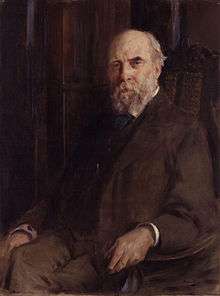William Cosmo Monkhouse
| William Cosmo Monkhouse | |
|---|---|
 William Cosmo Monkhouse by John McLure Hamilton[1] | |
| Born |
18 March 1840 London, U.K. |
| Died | 20 July 1901 (aged 61) |
| Nationality | English |
| Occupation | Poet and art critic |
| Spouse(s) | Laura Keymer (first wife), Leonora Eliza Blount (second wife) |
| Parent(s) | Cyril John Monkhouse (father) |
William Cosmo Monkhouse (18 March 1840 – 20 July 1901) was an English poet and critic.[2]
Biography
Monkhouse was born in London. His father, Cyril John Monkhouse, was a solicitor; his mother's maiden name was Delafosse. He was educated at St Paul's School, quitting it at seventeen to enter the board of trade as a junior supplementary clerk, from which grade he rose eventually to be the assistant-secretary to the finance department of the office. In 1870–71 he visited South America in connection with the hospital accommodation for seamen at Valparaíso, Chile, and other ports; and he served on different departmental committees, notably that of 1894–96 on the Mercantile Marine Fund. He was twice married: first, to Laura, daughter of James Keymer of Dartford; and, secondly, to Leonora Eliza, daughter of Commander Blount, R.N.
Cosmo Monkhouse was one of those who have not only a vocation, but an avocation. His first bias was to poetry, and in 1865 he issued A Dream of Idleness and Other Poems, a collection strongly coloured by his admiration for Wordsworth and Tennyson. It was marked by exceptional maturity, and scarcely received the recognition it deserved. Owing perhaps to this circumstance, it was not till 1890 that he put forth Corn and Poppies, a collection which contains at least one memorable effort in the well-known "Dead March." Five years later appeared a limited edition of the striking ballad of The Christ upon the Hill, illustrated with etchings by William Strang. After his death his poetical output was completed by Pasiteles the Elder and other Poems (including The Christ upon the Hill).
In 1868 Monkhouse wrote a novel, A Question of Honour. Then, after preluding with a Life of Turner in the "Great Artists Series" (1879), he devoted himself almost exclusively to art criticism. Besides many contributions to the Academy, the Saturday Review, the Magazine of Art and other periodicals, he published volumes on The Italian Pre-Raphaelites (1887), The Earlier English Water-Colour Painters (1890 and 1897), In the National Gallery (1895) and British Contemporary Artists (1899). He wrote a monograph on the illustrator of Alice's Adventures in Wonderland entitled The Life and Work of Sir John Tenniel, R. I. (London: 1901). He was a contributor to the Dictionary of National Biography from the beginning. Monkhouse also wrote an excellent Memoir of Leigh Hunt in the "Great Writers Series" (1887).[3] He wrote a monograph on Chinese ceramics entitled A history and description of Chinese Porcelain, (Chapman, London 1901).
As an art critic Monkhouse's judgments were highly valued; and he had the rare gift of differing without offending, while he invariably secured respect for his honesty and ability. As a poet, his ambition was wide and his devotion to the art thorough.
Monkhouse died at Skegness on 2 July 1901.[4]
Family
He was twice married: first in 1865 to Laura, daughter of James Keymer of Dartford in Kent; second in 1873 to Leonora Eliza, the daughter of Commander Blount, R.N., by whom he had two sons and six daughters.[4]
Notes
| Wikisource has original works written by or about: William Cosmo Monkhouse |
References
-
 This article incorporates text from a publication now in the public domain: Chisholm, Hugh, ed. (1911). "Monkhouse, William Cosmo". Encyclopædia Britannica. 18 (11th ed.). Cambridge University Press.
This article incorporates text from a publication now in the public domain: Chisholm, Hugh, ed. (1911). "Monkhouse, William Cosmo". Encyclopædia Britannica. 18 (11th ed.). Cambridge University Press. -
 Dobson, Henry Austin (1912). "Monkhouse, William Cosmo". In Lee, Sidney. Dictionary of National Biography, 1912 supplement. London: Smith, Elder & Co.
Dobson, Henry Austin (1912). "Monkhouse, William Cosmo". In Lee, Sidney. Dictionary of National Biography, 1912 supplement. London: Smith, Elder & Co. - "Monkhouse, William Cosmo (1840–1901)". Oxford Dictionary of National Biography (online ed.). Oxford University Press. doi:10.1093/ref:odnb/35067. (Subscription or UK public library membership required.)
External links
| Wikimedia Commons has media related to William Cosmo Monkhouse. |
- Works by William Cosmo Monkhouse at Project Gutenberg
- Works by or about William Cosmo Monkhouse at Internet Archive
- Works by William Cosmo Monkhouse at LibriVox (public domain audiobooks)
